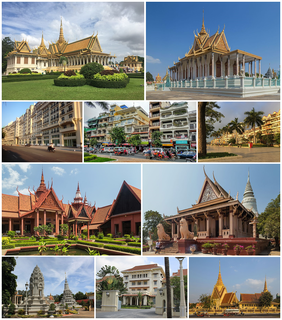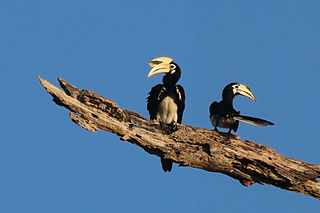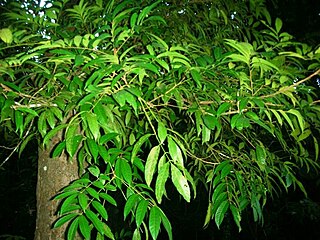
Phnom Penh is the capital and most populous city of Cambodia. It has been the national capital since the French protectorate of Cambodia, and has grown to become the nation's economic, industrial, and cultural centre.
Sindora siamensis is a species of tree in the subfamily Detarioideae of the family Fabaceae. It has an accepted infraspecific, the variety S. siamensis var. maritima (Pierre) K.Larsen & S.S.Larsen. See taxon box to the right below, and below for details on the variety maritima. The nominate species is found in many countries in tropical Asia. Like several other species in the genus Sindora, its wood is considered valuable; the least concern conservation status may reflect efforts to replant this species, but mortality rates are high. As well as the wood, the plant provides raw material for chemical products, food and drink, and domestic utensils.

The oriental pied hornbill is an Indo-Malayan pied hornbill, a large canopy-dwelling bird belonging to the family Bucerotidae. Two other common names for this species are Sunda pied hornbill (convexus) and Malaysian pied hornbill.

Finlayson's squirrel or the variable squirrel is a species of rodent in the family Sciuridae. It is found in Cambodia, Laos, Myanmar, Thailand, and Vietnam. The species occurs in a wide range of wooded habitats, including gardens and parks in cities like Bangkok. It was named in honour of the Scottish naturalist and traveller George Finlayson.

Aglaia lawii is a species of tree in the family Meliaceae. As well as the autonym species, there are two subspecies accepted.

Aglaia spectabilis is a species of tree in the family Meliaceae, found from the Santa Cruz Islands in the southwest Pacific to Queensland (Australia), Southeast Asia, Yunnan (Zhōngguó/China) and the Indian subcontinent. It grows from a 1m shrub to an emergent 40m tall tree, depending on the habitat. Its wood is commercially exploited as timber, but otherwise is of poor quality with limited use. The fruit are eaten, and used in folk medicine. The seeds are large in comparison to other plants, and a major source of dispersal of the species are hornbills eating the fruit, flying away from the tree and regurgitating the seeds.
The Cambodian humanitarian crisis from 1969 to 1993 consisted of a series of related events which resulted in the death, displacement, or resettlement abroad of millions of Cambodians.

Antidesma ghaesembilla is a species of plant in the Phyllanthaceae family. It is native to an area from northern Australia to the Philippines, Zhōngguó/China, and west to India. The shrub or tree usually grows in moist soils in plant communities ranging from savannah to gallery forest to closed forest. It is associated with a number of species of fungus, insects and animals, including emus. Amongst the Mangarrayi and Yangman people of north Australia, the sweet ripe fruit of the tree are much appreciated and linked to the build-up season and to the koel. As well as food, the plant is used as a calendar-plant, for dyeing, in traditional medicine, in religious/magical practices, as fuel, and as an insecticide.
Ziziphus cambodiana is a deciduous thorny shrub, or vine, some 2–6 m tall, found growing in secondary undergrowth in Cambodia, Laos and Vietnam, and northern Thailand.

A small tree with tortuous twigs, Dillenia pentagyna is a member of the family Dilleniaceae, and is found from Sulawesi to South-Central China to India and Sri Lanka. Material from the tree has some minor uses.

Antidesma japonicum is a shrub in the family Phyllanthaceae. It is found in Southeast Asia, China and Japan. It provides food and fuel. A. japonicum has two accepted varieties: the nominate variety, A. japonicum var. japonicum; and the robustius variety, A. japonicum var. robustius.
Aporosa ficifolia is a species of shrub in the family Phyllanthaceae. It grows 2-8m tall, it has a restricted habitat, growing in lowland open or pine forests up to 700m elevation.
Erythroxylum cambodianum is a shrub in the family Erythroxylaceae. It grows in Vietnam, Laos, Cambodia and Thailand. The wood is used for pickets and as firewood.
Memecylon caeruleum is a shrub or tree species in the Melastomataceae family. It is found from New Guinea, west through Southeast Asia to Tibet, Zhōngguó/China. It has become an invasive weed in the Seychelles. It has some local use for wood and food.
Pantadenia adenanthera is a shrub in the Euphorbiaceae family. It is found in parts of Southeast Asia. The species is used for its wood and edible fruit.
Stixis obtusifolia is a shrub or liana in the Resedaceae family. It is found in parts of Southeast Asia. The wood is used as fuel, the leaves as a tea.
Strychnos nux-blanda is a shrub or small tree in the Loganiaceae family. It is native to Southeast Asia and Assam. The wood is used as fuel; seeds are toxic, but used in folk-medicine. It is one of the plants featured in the garden of King Narai (1633–88) at Lopburi, Thailand.

Aporosa octandra is a species of plant in the family Phyllanthaceae found from Queensland and New Guinea to Indonesia, Zhōngguó/China and India. It is a highly variable plant with 4 named varieties. Its wood is used in construction and to make implements, its fruit is edible. The Karbi people of Assam use the plant for dyeing, textile colours have quite some significance in their culture.
Aporosa tetrapleura is a species of plant in the family Phyllanthaceae found in Cambodia and Vietnam. The wood is used in house and cattle barn construction and as firewood.
Aporosa villosa is a species of shrub or small tree in the family Phyllanthaceae. It is found in Southeast Asia, including the Nicobar, Andaman and Paracel Islands. There are some traditional medicinal uses for plant, particularly around care after childbirth. The shrub is often a pioneer species, tolerant of full sun, but intolerant of frequent fires.








